There was a time when the latest kitchen designs were a primary topic of debate and rather a missed affair. People would always peek into local showrooms to picture how a particular style of floor colour or cabinet can transform your kitchen, critical for taking an informed decision.
Now that we along with the kitchen designs has moved into the 21st century, there isn’t any need to stress on our imaginations simply to bring it to life. Technology has all what it takes to give latest kitchen designs a reality shape and designing that complement to the home interior.
Advanced, sophisticated & user-friendly software
Interior designers and architects nowadays rarely brainstorm on the picture of a building, a room or kitchen without using advanced CAD (Computer Aided Design) software. All such software can’t just render a room in 3D but presents a multitude of options in terms of fixtures, colours and fittings. It can even help in optimising the room design in terms of ergonomics.
The biggest advantage of CAD for consumers is ease of viewing the kitchen design once completed and numerous layouts per preference. Once all of this is rendered in 3D, picturing the actual design and results is far easier. Try out with the oven and sink as these are easiest places to reach when preparing food.
In addition, you’re able to view many different styles of kitchen fittings, flooring and fixtures to see which is most preferable. You can even get a clear image of a specific wall if it looks appealing with or without a plaster or perhaps the stripped back brick effect.
For architects and designers, the benefits of using CAD software are unlimited thus giving them more room for being productive. The can generate high-quality and detailed designs that can be modified easily as per client’s recommendations.
That’s not all! You can incorporate as many materials into the designs generated using CAD; further include them to the database as information is crucial during the actual production phase. This however significantly decreases the time it takes for a kitchen to transcend from design phase to the physical, finished build.
This is the biggest benefit for consumers, designers and manufacturers who complain over the delivery process being lengthy.
Extending the design to furniture
While cabinets, sinks and oven are always essential for a kitchen, furniture is another most important aspect that experienced significant transformation along with technology and latest kitchen designs. Dining table designs are getting sleeker, ergonomic and customisable per one’s needs. Nowadays, consumers prefer living their life around the furniture so it must fit to the aesthetic and overall environment.
Future of design
Designers can take their learning to a whole new level with first-hand knowledge of software, technological innovation and context of materials that blends perfectly with the environment. Additionally, this training has become an integral part of design curriculum to prepare the next generation of professional kitchen designers with full grasp on all the latest software and trends.
Many magazines nowadays feature articles on technological revolution, laying a huge impact on the industry, its application and evolution in near future. As we speak, digital technology further takes the trends to the next level, giving mere illustrations a reality shape into our homes. 3D renderings and virtual tours allow customers to actually live the latest kitchen designs even before completion.
Conclusion
A word of thanks to خزائن مطابخ for providing such amazing insights over the topic. Anticipating the future and it won’t be long before holographic design technology take over today’s 3D and cutting-edge digital technology. In fact, holograms have already started taking a limited number of industries so we’re likely to see them working with the latest kitchen designs and that’ll be a dream come true.





